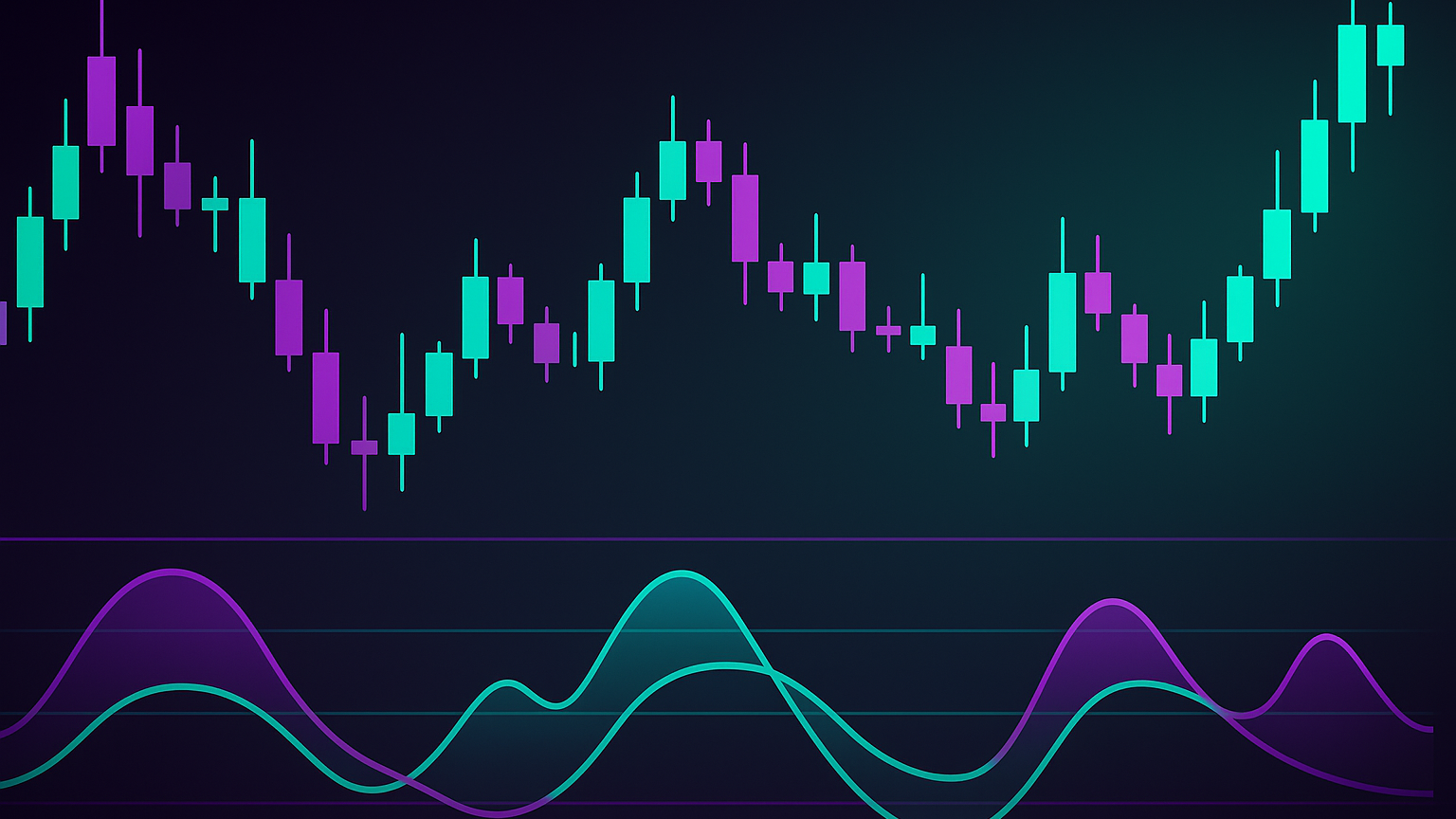Learn how the Movement Index (MI) can enhance your trading strategies by identifying market trends and surge potential effectively.
The Movement Index (MI) is a technical indicator used to evaluate market momentum and trend strength. It blends the +DI (upward movement), -DI (downward movement), and ADX (overall trend strength). Here’s what matters most:
- Key Signals
- +DI above –DI: Bullish momentum is building.
- –DI above +DI: Bearish momentum is dominant.
- ADX > 25: A strong, tradable trend is confirmed.
- How It Helps
- Pinpoints trend direction and strength.
- Improves entry / exit timing.
- Filters out sideways-market noise.
- Practical Application
- Combine MI with RSI, EMAs, and volume for deeper confirmation.
- Works for both trend-following and breakout setups.
- Example: A Microsoft back-test (Feb 2023 → Feb 2024) produced a 6.95 % net profit using MI-based signals.
For full-stack analysis—including automated pattern recognition—see what LuxAlgo offers.
How to Trade the DMI Indicator Based on 9,764 Tested Trades
Movement Index — Core Components
This section breaks down the core elements of the Movement Index, showing how trend direction and strength combine to create clear signals.
DI and ADX Components
MI relies on three directional elements:
Positive Directional Indicator (+DI)
- Tracks upward price movement.
- Turns bullish when +DI crosses above –DI.
Negative Directional Indicator (–DI)
- Measures downward price movement.
- Turns bearish when –DI crosses above +DI.
Average Directional Index (ADX)
- Quantifies trend strength in either direction.
- Readings above 25 flag strong, tradable trends.
Calculation Methods
MI uses Wilder’s smoothing to calculate its values:
True Range (TR) — the greatest of:
- Current high minus low
- Current high minus previous close
- Current low minus previous close
+DI14 = (Smoothed +DM14) / ATR14 × 100
-DI14 = (Smoothed -DM14) / ATR14 × 100
DX = (|+DI14 – -DI14|) / (|+DI14 + -DI14|) × 100
ADX = 14-period moving average of DX
Price Movement and Volatility
ADX values map directly to market conditions:
| ADX Value | Market Condition | Trading Implication |
|---|---|---|
| 0–25 | Range-bound | Low surge potential |
| 25–50 | Strong trend | Solid surge potential |
| 50–75 | Very strong trend | High surge potential |
| 75–100 | Extreme trend | Momentum may fade |
Because MI needs about 150 bars to smooth ADX, it excels at spotting medium- to long-term moves.
Reading Movement Index Signals
ADX Signal Levels
| ADX Value | Trend Strength |
|---|---|
| 0–20 | Weak / no trend |
| 20–25 | Trend emerging |
| 25–50 | Strong trend |
| 50–75 | Very strong trend |
| 75–100 | Extremely strong trend |
+DI / –DI Signal Crossovers
- +DI crosses above –DI + ADX > 25 → bullish momentum is expanding.
- –DI crosses above +DI + ADX > 25 → bearish momentum is strengthening.
ADX Trend Analysis
- Rising ADX = momentum building; consider adding to positions.
- Falling ADX > 25 = trend slowing but still valid.
- ADX jumping from < 20 to > 25 = breakout confirmation.
Trading Strategy Implementation
Below are three proven ways to use MI, with references to the Backtesting Assistant so you can validate each tactic.
Trend Following with MI
Focus on ADX > 25. A bullish setup often emerges when +DI moves above –DI while the ADX remains strong.
- Net profit: 6.95 %
- Win rate: 45.45 %
- Profit factor: 1.602
- Max drawdown: 9.47 %
MI Paired with Other Indicators
| Indicator Type | Purpose | Implementation |
|---|---|---|
| Trend | Confirm direction | 50- & 200-day EMAs |
| Momentum | Validate strength | RSI 30–70 zone |
| Volume | Confirm breakouts | Volume spikes |
Breakout Trading with MI
- ADX > 25
- Rising volume
- Price breaks support / resistance
- +DI / –DI crossover aligns with the break
Tools for Movement Index Analysis
LuxAlgo offers exclusive toolkits—built for TradingView—that streamline MI analysis and help traders catch momentum early.
LuxAlgo MI Toolkits
Each toolkit can plug directly into MI-based strategies:
| Toolkit | Features | Primary Use-Case |
|---|---|---|
| Price Action Concepts (PAC) | Pattern detection, volumetric order blocks | Confirm MI-identified trend pivots |
| Signals & Overlays (S&O) | Adaptive signals, dynamic overlays | Track MI crossovers & divergences |
| Oscillator Matrix (OSC) | Real-time divergence & money-flow metrics | Gauge momentum shifts within MI trends |
Compare every toolkit side-by-side on the LuxAlgo Toolkits overview.
Want the fine print? Check the full indicator pages for Price Action Concepts™, Signals & Overlays™, and Oscillator Matrix™.
MI Strategy Testing
The AI Backtesting Assistant blog post shows how to stress-test MI ideas in minutes, drawing from a pool of 6 million strategies.
Learning Resources
- Video tutorials: Step-by-step guides on MI implementation.
- Toolkit documentation: Read the introductions for PAC, S&O, and OSC.
- Advanced settings: Fine-tune with the PAC settings guide or explore OSC confluence tools.
- Indicator overlays: Learn layering techniques inside S&O indicator overlays.
- Discord community: Real-time discussions & support.
LuxAlgo now serves more than 15 000 traders and offers three plans:
- Free Plan ($0): Lifetime access to the Library—hundreds of indicators across 5 + platforms.
- Premium Plan ($39.99 / month): Advanced signal modes, alerts, and oscillator tools on TradingView.
- Ultimate Plan ($59.99 / month): Includes AI Backtesting, all Premium features, and upcoming exclusive releases.
Conclusion
Summary Points
| Component | Signal Type | Trading Implication |
|---|---|---|
| +DI / –DI Crossovers | Directional | Buy on +DI ↑; sell on –DI ↑ |
| ADX Level | Trend strength | Trade trends when ADX > 25 |
| Combined Signals | Confirmation | Use both for robust decisions |
Getting Started
- Begin with Free analysis — Add MI from the Library and look for ADX > 25.
- Layer your approach — Start with trend-following, then integrate PAC for structure, OSC for momentum, and S&O for precision entries.
- Back-test before you risk capital — Use the AI Backtesting Assistant to iterate strategies quickly.
FAQs
How can I combine the Movement Index with indicators like RSI and EMAs to improve my trading strategy?
Combining the Movement Index with tools like the Relative Strength Index (RSI) and Exponential Moving Averages (EMAs) can strengthen your trading strategy by providing a clearer picture of market conditions. Each indicator brings something unique to the table: the Movement Index signals potential market surges, the RSI pinpoints overbought or oversold levels, and EMAs confirm the overall trend direction.
For instance, imagine spotting a potential bullish surge using the Movement Index. You could then check the RSI to ensure the market isn't overbought (staying below 70) and verify that the price is trading above a key EMA to confirm the upward trend. This layered approach minimizes false signals and helps you make more accurate decisions, improving your timing for entering or exiting trades.
What makes LuxAlgo's tools ideal for analyzing the Movement Index and spotting market opportunities?
LuxAlgo's tools bring a fresh perspective to analyzing the Movement Index, simplifying the process of spotting market trends and potential price movements. By leveraging advanced AI-powered insights, these tools enhance signal precision, cut down on false positives, and can be adjusted to match your specific trading preferences with customizable settings.
They also take the complexity out of market analysis by automating calculations and integrating smoothly with popular platforms like TradingView. On top of that, LuxAlgo's backtesting feature lets you experiment with strategies using historical data, giving you a chance to fine-tune your decisions and stay ahead in the trading game. For traders aiming to explore new opportunities, LuxAlgo offers a robust set of tools to elevate their approach.
When is the Movement Index most effective for identifying potential market surges?
The Movement Index works best in trending markets, particularly when the Average Directional Index (ADX) is above 25. This level signals a strong trend, helping the Movement Index effectively measure the strength and direction of price movements while minimizing false signals.
However, in range-bound or sideways markets where the ADX falls below 20, its reliability decreases. These conditions lack a clear trend, making the Movement Index less dependable for identifying significant price shifts.
References
- LuxAlgo Website
- Backtesting Assistant – Fetching Strategies
- Support & Resistance Dynamic Indicator
- Pure Price Action Structures Indicator
- AI Backtesting Assistant Blog Post
- Price Action Concepts Indicator
- Signals & Overlays Indicator
- Oscillator Matrix Indicator
- Price Action Concepts Toolkit Docs
- Signals & Overlays Toolkit Docs
- Oscillator Matrix Toolkit Docs
- LuxAlgo Toolkits Overview
- Oscillator Matrix Confluence Docs
- Signals & Overlays Indicator Overlay Docs
- Price Action Concepts Settings Docs








